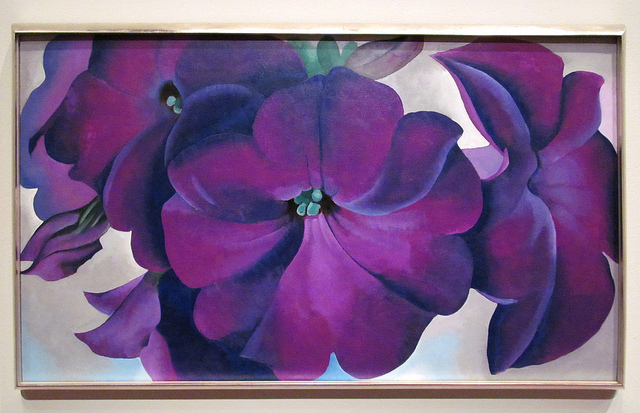“A flower is relatively small,” Georgia O’Keeffe once wrote. “Everyone has many associations with a flower — the idea of flowers … Still — in a way — nobody sees a flower — really — it is so small — we haven’t time — and to see takes time, like to have a friend takes time. If I could paint the flower exactly as I see it no one would see what I see because I would paint it small like the flower is small. So I said to myself — I’ll paint what I see — what the flower is to me but I’ll paint it big and they will be surprised into taking time to look at it — I will make even busy New Yorkers take time to see what I see of flowers.”
O’Keeffe’s quote sits alongside a print of her 1927 painting “Red Cannas” on my writing desk next to a flickering candle and other sacred memorabilia arranged about me to foster my inspiration and beckon my muse. I open my window blinds in front of the desk, clear away the clutter and the laptop, set out a blank sheet of paper, my Bible, and a pen. I open to the week’s lectionary text, and for a long time I look at the text, then out the window, then back at the text, then down at the candle. I observe what I am feeling, thinking, remembering, wondering. Occasionally I jot notes. This is how the sermon begins …
In the same way a good painting captures the onlooker, the sermon ought to surprise listeners into paying attention to the sacred text. For the preacher this is a modest yet challenging goal. We are dealing with an ancient text nearly no one really sees anymore. They have associations with the text, ideas about the Scriptures, but not that many people are pausing to really see.
How can we paint the text big? How can we paint it big if it is small and tangential to us? We must first be surprised ourselves. We must pay careful attention to the story, the way the poet studies the rose, the way the artist sees not just the object, but sees also the way the light hits it and where the shadows are. We must get still and quiet until there is space enough within for even the preacher to be surprised.
How can we be surprised by what we already know, by what we have read a hundred times before? Do not come to the text thinking you know. That will never do. The painting will flop. Come to the text with your wonder still intact. You cannot do so if you rush. Come to the text soul-first. Your mind can catch up later. Come to the text like a child coming upon an adventure.
You have heard these words so many times. Hear them again. Hear them from a deeper place. Hear them without your usual filters. Hear them from your flawed humanness; hear them from the part of you that knows God. Hear them with full-blown curiosity. Hear them again.
Your first task is to teach yourself how to listen. Only then will the people want to listen to you. Only then will you have anything worth saying.
When you create art, you have so little control over how your work is seen or heard or interpreted by others. This is as it should be. Art invites the Spirit in, and what happens between your art and the listener’s reception of it becomes like a holy secret for which you cannot take any credit since you never could have predicted the impact. When you do it right, with heart and soul, art-making keeps you humble.
The unfortunate news of our current situation is that for many people, the sloppy, arrogant artistry of the less soulful has painted an entirely wrong picture of the faith. This news can be either a discouragement to the preacher, or a serious invitation to keep painting. We get the exhilarating job of helping wounded hearts re-imagine the meaning of a text and finally, really see the big, magnificent love of God.

